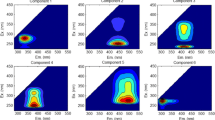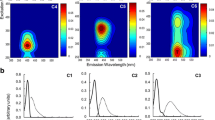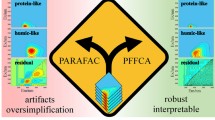Abstract
In this study, the variations in the fluorescent components of dissolved organic matter (DOM) were tracked for an aerobic submerged membrane bioreactor (MBR) at three different operation stages (cake layer formation, condensation, and after cleaning). The fluorescent DOM was characterized using excitation–emission matrix (EEM) spectroscopy combined with parallel factor analysis (PARAFAC). Non-aromatic carbon structures appear to be actively involved in the membrane fouling for the cake layer formation stage as revealed by much higher UV-absorbing DOM per organic carbon found in the effluent versus those inside the reactor. Four fluorescent components were successfully identified from the reactor and the effluent DOMs by EEM-PARAFAC modeling. Among those in the reactor, microbial humic-like fluorescence was the most abundant component at the cake layer formation stage and tryptophan-like fluorescence at the condensation stage. In contrast to the reactor, relatively similar composition of the PARAFAC components was exhibited for the effluent at all three stages. Tryptophan-like fluorescence displayed the largest difference between the reactor and the effluent, suggesting that this component could be a good tracer for membrane fouling. It appears that the fluorescent DOM was involved in membrane fouling by cake layer formation rather than by internal pore adsorption because its difference between the reactor and the effluent was the highest among all the four components, even after the membrane cleaning. Our study provided an insight into the fate and the behavior fluorescent DOM components for an MBR system, which could be an indicator of the membrane fouling.







Similar content being viewed by others
References
Le-Clech P, Chen V, Fane TAG (2006) Fouling in membrane bioreactors used in wastewater treatment. J Membr Sci 284:17–53
Tang S, Wang Z, Wu Z, Zhou Q (2010) Role of dissolved organic matters (DOM) in membrane fouling of membrane bioreactors for municipal wastewater treatment. J Membr Sci 178:377–384
Yao M, Ladewig B, Zhang K (2011) Identification of the change of soluble microbial products on membrane fouling in membrane bioreactor (MBR). Desalination 278:126–131
Barker DJ, Stuckey DC (1999) A review of soluble microbial products (SMP) in wastewater treatment systems. Water Res 33:3064–3082
Hong S, Aryal R, Vigneswaran S, Johir MAH, Kandasamy J (2012) Influence of hydraulic retention time on the nature of foulant organics in a high rate membrane bioreactor. Desalination 287:116–122
Kimura K, Naruse T, Watanabe Y (2009) Changes in characteristics of soluble microbial products in membrane bioreactors associated with different solid retention times: relation to membrane fouling. Water Res 43:1033–1039
Wang Z, Wu Z, Tang S (2009) Characterization of dissolved organic matter in a submerged membrane bioreactor by using three-dimensional excitation and emission matrix fluorescence spectroscopy. Water Res 43:1533–1540
Wang Z, Tang S, Zhu Y, Wu Z, Zhou Q, Yang D (2010) Fluorescent dissolved organic matter variations in a submerged membrane bioreactor under different sludge retention times. J Membr Sci 355:151–157
Meng F, Zhou Z, Ni BJ, Zheng X, Huang G, Jia X, Li S, Kraume M (2011) Characterization of the size-fractionated biomacromolecules: tracking their role and fate in a membrane bioreactor. Water Res 45:4661–4671
Choi BG, Cho J, Song KG, Maeng SK (2013) Correlation between effluent organic matter characteristics and membrane fouling in a membrane bioreactor using advanced organic matter characterization tools. Desalination 309:74–83
Hur J, Cho J (2012) Prediction of BOD, COD, and total nitrogen concentrations in a typical urban river using a fluorescence excitation-emission matrix with PARAFAC and UV absorption indices. Sensors 12:972–986
Li WH, Sheng GP, Liu XW, Yu HQ (2008) Characterizing the extracellular and intracellular fluorescent products of activated sludge in a sequencing batch reactor. Water Res 42:3173–3181
Yu GH, He PJ, Shao LM (2010) Novel insights into sludge dewaterability by fluorescence excitation–emission matrix combined with parallel factor analysis. Water Res 44:797–806
Galinha CF, Carvalho G, Portugal CAM, Guglielmi G, Reis MAM, Crespo JG (2012) Multivariate statistically-based modelling of a membrane bioreactor for wastewater treatment using 2D fluorescence monitoring data. Water Res 46:3623–3636
Zhang J, Chua HC, Fane AG (2006) Factors affecting the membrane performance in submerged membrane bioreactors. J Membr Sci 284:54–66
American Public Health Association (APHA), American Water Works Association (AWWA), Water Environment Federation (WEF) (2005) Standard methods for the examination of water and wastewater, 20th edn. APHA/AWWA/WEF, Washington, DC
Hur J, Hwang SJ, Shin JK (2008) Using synchronous fluorescence technique as a water quality monitoring tool for an urban river. Water Air Soil Pollut 191:231–243
Ishii SKL, Boyer TH (2012) Behavior of reoccurring PARAFAC components in fluorescent dissolved organic matter in natural and engineered systems: a critical review. Environ Sci Technol 46:2006–2017
Zsolnay A, Baigar E, Jimenez M, Steinweg B, Saccomandi F (1999) Differentiating with fluorescence spectroscopy the sources of dissolved organic matter in soils subjected to drying. Chemosphere 38:45–50
Simon J (2011) The MBR book: principles and applications of membrane bioreactors for water and wastewater treatment, 2nd edn. Elsevier, Butterworth-Heinemann, Oxford
Song KG, Cho J, Ahn KH (2009) Effects of internal recycling time mode and hydraulic retention time on biological nitrogen and phosphorus removal in a sequencing anoxic/anaerobic membrane bioreactor process. Bioprocess Biosyst Eng 32:135–142
Cho J, Song KG, Ahn KH (2009) Contribution of microfiltration on phosphorus removal in the sequencing anoxic/anaerobic membrane bioreactor. Bioprocess Biosyst Eng 32:593–602
Yigit NO, Harman I, Civelekoglu G, Koseoglu H, Cicek N, Kitis M (2008) Membrane fouling in a pilot-scale submerged membrane bioreactor operated under various conditions. Desalination 231:124–132
Zhang Y, Zhang H, Chu H, Zhou X, Zhao Y (2013) Characterization of dissolved organic matter in a dynamic membrane bioreactor for wastewater treatment. Chin Sci Bull 15:1717–1724
Weishaar JL, Aiken GR, Bergamaschi BA, Fram MS, Fujii R, Mopper K (2003) Evaluation of specific ultraviolet absorbance as an indicator of the chemical composition and reactivity of dissolved organic carbon. Environ Sci Technol 37:4702–4708
Fuentes M, Gonzalez-Gaitano G, Ma Garcia-Mina J (2006) The usefulness of UV–visible and fluorescence spectroscopies to study the chemical nature of humic substances from soils and composts. Org Geochem 37:1949–1959
Zhou Z, Meng F, Chae SR, Huang G, Fu W, Jia X, Li S, Chen GH (2013) Microbial transformation of biomacromolecules in a membrane bioreactor: implications for membrane fouling investigation. PLoS One 7:e42270
Zhang Y, van Dijk MA, Liu M, Zhu G, Qin B (2009) The contribution of phytoplankton degradation to chromophoric dissolved organic matter (CDOM) in eutrophic shallow lakes: field and experimental evidence. Water Res 43:4685–4697
Fellman JB, Hood E, Spencer RGM (2010) Fluorescence spectroscopy opens new windows into dissolved organic matter dynamics in freshwater ecosystems: a review. Limnol Oceanogr 55(6):2452–2462
Chen M, Price RM, Yamashita Y, Jaffé R (2010) Comparative study of dissolved organic matter from groundwater and surface water in the Florida coastal Everglades using multi-dimensional spectrofluorometry combined with multivariate statistics. Appl Geochem 25:872–880
Drews A, Mante J, Inversen V, Vocks M, Lesjean B, Kraume M (2007) Impact of ambient conditions on SMP elimination and rejection in MBRs. Water Res 41:3850–3858
Acknowledgments
This work was supported by grants from the National Research Foundation of Korea funded by the Korean Government (No. NRF-2011-0029028 and No. 2012R1A1A1006307).
Author information
Authors and Affiliations
Corresponding author
Rights and permissions
About this article
Cite this article
Hur, J., Shin, J., Kang, M. et al. Tracking variations in fluorescent-dissolved organic matter in an aerobic submerged membrane bioreactor using excitation–emission matrix spectra combined with parallel factor analysis. Bioprocess Biosyst Eng 37, 1487–1496 (2014). https://doi.org/10.1007/s00449-013-1120-2
Received:
Accepted:
Published:
Issue Date:
DOI: https://doi.org/10.1007/s00449-013-1120-2




